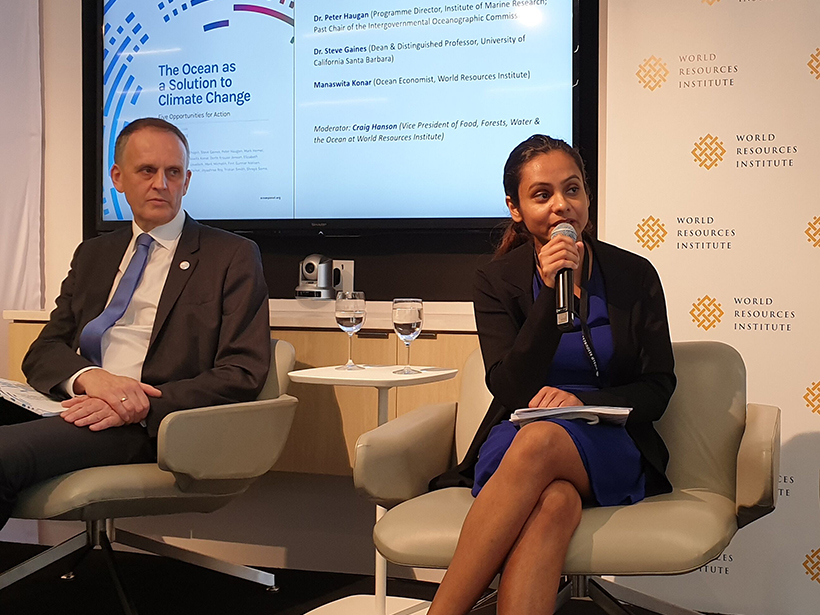The global ocean is not only “a victim of climate change” but also “a major part of the climate solution,” according to a new report commissioned by the High Level Panel for a Sustainable Ocean Economy.
“The ocean is on the front lines of the battle against climate change,” the report says, with the ocean already absorbing 93% of the heat trapped by human-generated carbon dioxide emissions.
“Ocean-based climate action can play a much bigger role in shrinking the world’s carbon footprint than was previously thought.”
However, ocean-based mitigation options could reduce greenhouse gas emissions by nearly 4 billion tonnes of carbon dioxide equivalent per year in 2030, and by more than 11 billion tonnes in 2050 relative to projected business as usual emissions, states the report, “The Ocean as a Solution for Climate Change: 5 Opportunities for Action,” issued on 23 September. While the report stresses that deep cuts in greenhouse gas emissions from terrestrial sources also are needed, these projected reductions “are larger than the emissions from all current coal-fired plants worldwide.”
“Ocean-based climate action can play a much bigger role in shrinking the world’s carbon footprint than was previously thought,” Peter Haugan, one of the expert authors of the report, said at a 3 October briefing at the World Resources Institute (WRI) in Washington, D.C.
Opportunities and Ancillary Benefits
The five areas that the report analyzes as opportunities for ocean-based action to mitigate greenhouse gas emissions include renewable energy; ocean-based transport; coastal and marine ecosystems; fisheries, aquaculture, and dietary shifts; and carbon storage in the seabed.
The opportunities recognized by the report are practical and largely familiar: investing in offshore energy sources (including wind and tidal); increasing energy efficiency for oceangoing vessels; conserving blue carbon ecosystems; shifting to low-carbon marine food sources; and investing in more research into seabed carbon storage.
“What was exciting to me was the fact that [the report] looked beyond climate-related benefits.”
At the briefing, speakers said that these opportunities to curb emissions come with many potential side benefits. “What was exciting to me was the fact that [the report] looked beyond climate-related benefits. It looked at nonclimate benefits, which is an important decision factor for many governments,” said Manaswita Konar, an expert author of the report and an ocean economist at WRI.
For example, more energy efficient shipping could be a win–win by helping governments and industry save money on fuel. Dietary shifts could dramatically lower freshwater use and land conversion associated with food production. Preserving blue carbon ecosystems could help mitigate cyclone damage for coastal communities.
The ancillary benefits of mitigation strategies were echoed by Alfonso Silva Navarro, Chile’s ambassador to the United States, at the briefing. The mitigation potentials of the report’s five focus areas “are critical to fight climate change,” he said, while also providing potential economic, social, and environmental benefits, including employment opportunities, enhanced global food security, and the reduction of ocean acidification.
“This is not easy. It will require greater political will, clear policy signals to support private-sector engagement, finance mechanisms, and development of new technologies.”
“This is not easy,” Navarro said. “It will require greater political will, clear policy signals to support private-sector engagement, finance mechanisms, and development of new technologies.”
Haugan, who is a program director at the Institute of Marine Research in Bergen, Norway, told Eos that to achieve the goals of the report, there are many hurdles to overcome, including inertia and strong economic forces that resist change and want to maintain the status quo. However, Haugan said that he is fairly optimistic that the changes envisioned in the report can happen. “There are so many opportunities for wealth and prosperity by using the ocean in a better way than we’re doing,” Haugan said, as an example of why he is hopeful.
Achieving the report’s goals “is doable,” Haugan said. It’s just a question of getting the right conditions in place and realizing the potential and going full speed forward.”
—Randy Showstack (@RandyShowstack), Staff Writer
Citation:
Showstack, R. (2019), Ocean-based actions provide big opportunities to curb emissions, Eos, 100, https://doi.org/10.1029/2019EO135003. Published on 07 October 2019.
Text © 2019. AGU. CC BY-NC-ND 3.0
Except where otherwise noted, images are subject to copyright. Any reuse without express permission from the copyright owner is prohibited.

